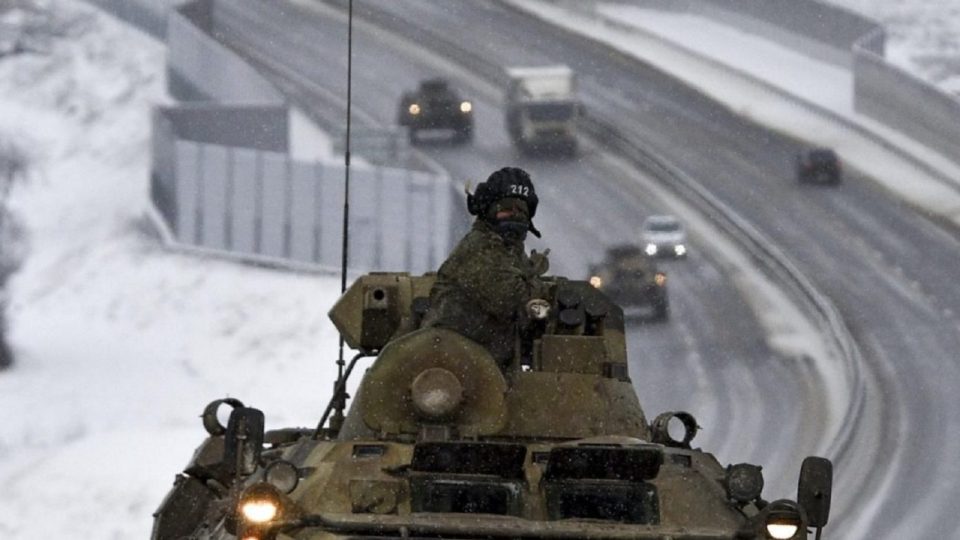
Ukraine: What would a Russian invasion actually look like?

By David J Galbreath, Professor of International Security, University of Bath
Despite suggestions to the contrary from the Kremlin, Ukraine remains surrounded by Russian troops, both along its long border with Russia and from within occupied Crimea. The Russian Federation has deployed land, air and naval forces that give the Kremlin a range of possibilities should it seek to initiate military action.
Not for the first time, Russian forces look set to challenge the sovereignty of Ukraine, and the west appears no closer to knowing what to do about it without risking war between nuclear armed states.
Russia has been laying the ground for military action against Ukraine since 2014, when it seized Crimea and thereby gained a more substantial military foothold to the south.
Meanwhile, the ongoing war in Ukraine’s Donbas region allowed Russian security and intelligence units to continue to gauge Ukrainian military and paramilitary operations.
In spring 2021, the Russian Federation ramped up actions against Ukraine, stopping short of actual war.
The Federation launched cyber-attacks and misinformation campaigns as well as disrupting the energy supply.
The Ukrainian Security Service has identified operational and sleeper units from Russia’s Federal Security Service, Foreign Intelligence Service, Military Intelligence and Special Forces operating within its borders.
If military action does occur, there are three likely scenarios for how it would play out.
The first is the decapitation approach. Russian military and security forces would seek to remove the current government and state powers, in order to instead replace them with people more favourable to (and owned by) Moscow.
Also read: US warns Moscow of consequences if it invades Ukraine; calls China ‘tacit supporter’
Perhaps surprisingly, this would entail keeping on some people who are already working in the Ukrainian state.
There are figures who have shown sympathies for and have worked with the Russian Federation.
This scenario would probably entail security and intelligence units on the ground in Ukraine as well as units from the military exercise currently being conducted in Belarus. The greatest concern for Russia in this scenario would be how the Ukrainian military and police would respond.
There may also be a significant public backlash against a change of government led from Moscow.
The second possibility is the eastern war approach. Here, Russian forces would seek to reinforce the breakaway regions in the Donbas with arms, supplies and intelligence.
These areas would then be used as a springboard to take more Ukrainian territory to more fully cover those areas where ethnic Russians and Russian speaking Ukrainians are located.
Such a manoeuvre could take Russian troops as far as the Dnieper river, which splits the country into east and west. It could also stretch across the coast of the Black Sea all the way to the Moldova border (where another Russian reinforced breakaway region is located).
Such an operation would be supported by military forces stationed in and around the Russian region of Rostov-on-Don, to the east of Ukraine, forces to the south stationed in Crimea and also probably Russian army motor and rifle battalions stationed in the breakaway Transnistria in Moldova.
The final possibility is the full invasion approach.
All of those forces mentioned thus far as well as air units located further north would seek to defeat Ukraine militarily.
They would use recent experience in combat operations in Syria to defeat any popular insurgency against Russian forces.
This approach would be devastating for the people of Ukraine. Large-scale death tolls would be expected across the Ukrainian military and police forces as well as among local populations adjacent to battles.
There would be major flows of refugees to the west of Ukraine and into the bordering states of Poland, Hungary, Romania and Moldova.
Such a refugee crisis could be the largest in Europe since the second world war.
It is important to note that these approaches are not mutually exclusive.
They could even occur sequentially should the Kremlin be unsatisfied with the changes it finds in Ukraine or the west.
Regardless of what Russia does, other countries with unsettled disputes over breakaway territories, such as Moldova with Transnistria, and Georgia with South Ossetia and Abkhazia, will be watching events nervously.
A victory in Ukraine for Russia might well fuel actions against these countries in the future.
And if the west fails to respond robustly, even countries like Estonia and Latvia could face threats in the future.
Russia’s military threat against Ukraine has put the west in a difficult position. It has to decide how to deal with a belligerent Russia and how far it should expand its membership to, say, Ukraine or Georgia and beyond.
Nor are these predicaments helped by the fact that the United States is more concerned with China, the South China Sea, and the status of Taiwan these days than the fate of eastern Europe.
Also read: Explainer: What’s NATO, and why does Ukraine want to join?
What’s more, the very future of NATO may be on the line if it cannot have a credible response to Ukraine through diplomacy, military assistance and maybe even military response.
Such a loss of credibility would be a major win for Russia, which sees NATO as a threat to its own national security and global strategy to regain power. In other words, the significance of the situation in Ukraine cannot be underestimated.

